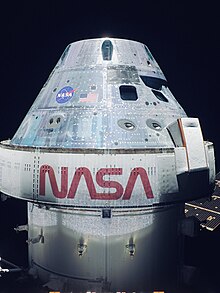
Back Orion (nau espacial) AN أوريون (مركبة فضاء) Arabic Арыён (касмічны карабель) Byelorussian Орион (космически кораб) Bulgarian ওরায়ন (মহাকাশযান) Bengali/Bangla Orion (nau espacial) Catalan Orion (kosmická loď) Czech Orion (rumfartøj) Danish Orion (Raumschiff) German Orion Greek
 Photo of Orion taken during the flight of Artemis 1 | |
| Manufacturer | |
|---|---|
| Operator | NASA[1] |
| Applications | Crewed exploration beyond LEO[2] |
| Project cost | US$21.5 billion nominal ($26.3 billion inflation adjusted to 2022) |
| Specifications | |
| Spacecraft type | Crewed |
| Launch mass |
|
| Dry mass |
|
| Payload capacity | 220 lb (100 kg) return payload |
| Crew capacity | 4[1] |
| Volume |
|
| Power | Solar |
| Regime | Lunar Transfer Orbit, lunar orbit |
| Design life | 21.1 days[3] |
| Dimensions | |
| Length | 10 feet 10 inches (3.30 m) |
| Diameter | 16 feet 6 inches (5.03 m) |
| Production | |
| Status | In service |
| On order | 6–12 (+3 ordered before 2019) [5] |
| Built | 4 |
| Launched | 2 |
| Maiden launch | December 5, 2014 |
| Related spacecraft | |
| Derived from | |
 | |
Orion (Orion Multi-Purpose Crew Vehicle or Orion MPCV) is a partially reusable crewed spacecraft used in NASA's Artemis program. The spacecraft consists of a Crew Module (CM) space capsule designed by Lockheed Martin and the European Service Module (ESM) manufactured by Airbus Defence and Space. Capable of supporting a crew of four beyond low Earth orbit, Orion can last up to 21 days undocked and up to six months docked. It is equipped with solar panels, an automated docking system, and glass cockpit interfaces modeled after those used in the Boeing 787 Dreamliner. A single AJ10 engine provides the spacecraft's primary propulsion, while eight R-4D-11 engines, and six pods of custom reaction control system engines developed by Airbus, provide the spacecraft's secondary propulsion. Orion is intended to launch atop a Space Launch System (SLS) rocket, with a tower launch escape system.
Orion was conceived in the early 2000s by Lockheed Martin as a proposal for the Crew Exploration Vehicle (CEV) to be used in NASA's Constellation program and was selected by NASA in 2006. Following the cancellation of the Constellation program in 2010, Orion was heavily redesigned for use in NASA's Journey to Mars initiative; later named Moon to Mars. The SLS became Orion's primary launch vehicle, and the service module was replaced with a design based on the European Space Agency's Automated Transfer Vehicle. A development version of Orion's CM was launched in 2014 during Exploration Flight Test-1, while at least four test articles were produced. Orion was primarily designed by Lockheed Martin Space Systems in Littleton, Colorado, with former Space Shuttle engineer Julie Kramer White at NASA as Orion's chief engineer.[6]
As of 2022[update], three flight-worthy Orion spacecraft are under construction, with one completed and an additional one ordered,[a] for use in NASA's Artemis program.
The first completed unit, CM-002, was launched on November 16, 2022 on Artemis 1.[9][10][11]
- ^ a b "Orion Reference Guide" (PDF). NASA Johnson Space Center. Retrieved September 29, 2023.
- ^ "NASA Authorization Act of 2010". Thomas.loc.gov. Archived from the original on December 19, 2010. Retrieved November 20, 2010.
- ^ Bergin, Chris (July 10, 2012). "NASA ESD set key Orion requirement based on Lunar missions". NASASpaceFlight.com. Archived from the original on July 17, 2012. Retrieved July 23, 2012.
- ^ "Orion Quick facts" (PDF). NASA. August 4, 2014. Archived (PDF) from the original on June 3, 2016. Retrieved October 29, 2015.
- ^ "NASA Commits to Long-term Artemis Missions with Orion Production Contract". NASA. September 23, 2019. Archived from the original on June 24, 2020. Retrieved April 18, 2020.
- ^ Cesar, Alan (December 15, 2023). "An Aerospace Titan Rooted in the Midwest". Aerogram. Retrieved January 9, 2024.
- ^ Foust, Jeff (September 24, 2019). "NASA awards long-term Orion production contract to Lockheed Martin". SpaceNews. Retrieved December 10, 2019.
The Orion Production and Operations Contract includes an initial order of three Orion spacecraft, for missions Artemis 3, 4 and 5, for $2.7 billion.
- ^ Clark, Stephen (November 29, 2019). "Earth observation, deep space exploration big winners in new ESA budget". Spaceflight Now. Archived from the original on December 10, 2019. Retrieved December 10, 2019.
ESA member states put up money for two Orion service modules at this week's summit in Seville. The power and propulsion modules will fly with NASA's Orion spacecraft carrying astronauts to the moon on the Artemis 3 and Artemis 4 missions...
- ^ Kraft, Rachel (May 16, 2022). "Artemis I Mission Availability". NASA. Retrieved September 7, 2022.
- ^ Wattles, Jackie (November 8, 2022). "NASA's Artemis I mission delayed again as storm barrels toward launch site". CNN. Warner Bros Discovery. Retrieved November 9, 2022.
- ^ "NASA Prepares Rocket, Spacecraft Ahead of Tropical Storm Nicole, Re-targets Launch". NASA. November 8, 2022. Retrieved November 9, 2022.
Cite error: There are <ref group=lower-alpha> tags or {{efn}} templates on this page, but the references will not show without a {{reflist|group=lower-alpha}} template or {{notelist}} template (see the help page).
© MMXXIII Rich X Search. We shall prevail. All rights reserved. Rich X Search